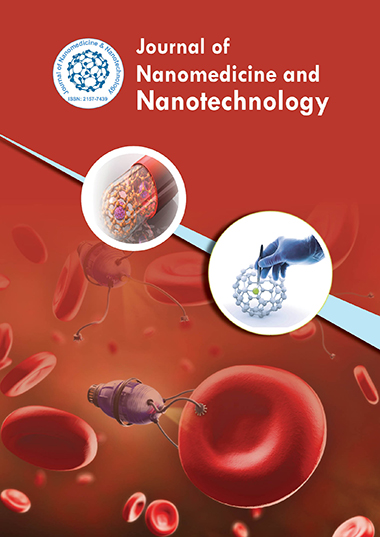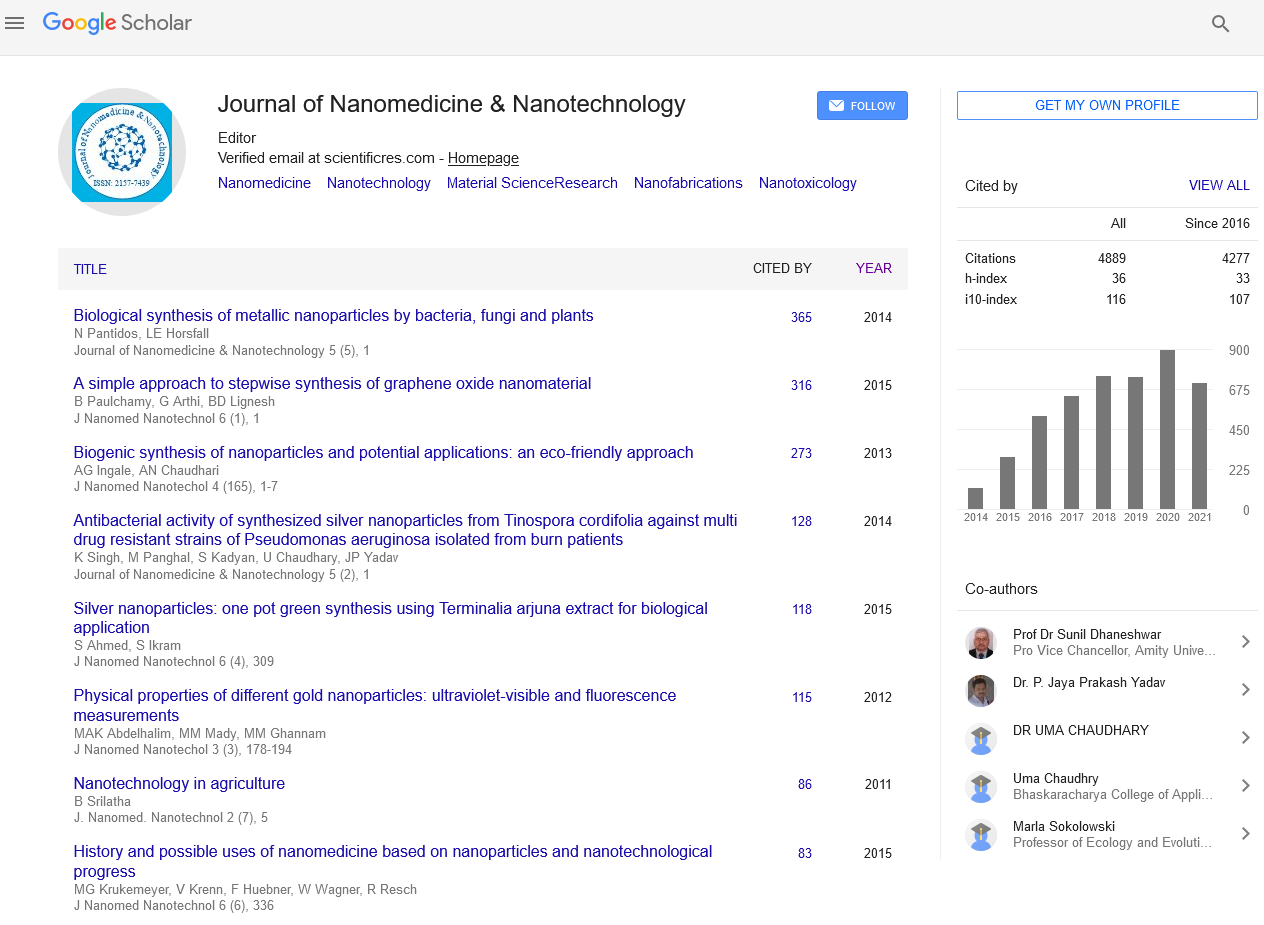Indexed In
- Open J Gate
- Genamics JournalSeek
- Academic Keys
- JournalTOCs
- ResearchBible
- China National Knowledge Infrastructure (CNKI)
- Scimago
- Ulrich's Periodicals Directory
- Electronic Journals Library
- RefSeek
- Hamdard University
- EBSCO A-Z
- OCLC- WorldCat
- SWB online catalog
- Virtual Library of Biology (vifabio)
- Publons
- MIAR
- Scientific Indexing Services (SIS)
- Euro Pub
- Google Scholar
Useful Links
Share This Page
Journal Flyer

Open Access Journals
- Agri and Aquaculture
- Biochemistry
- Bioinformatics & Systems Biology
- Business & Management
- Chemistry
- Clinical Sciences
- Engineering
- Food & Nutrition
- General Science
- Genetics & Molecular Biology
- Immunology & Microbiology
- Medical Sciences
- Neuroscience & Psychology
- Nursing & Health Care
- Pharmaceutical Sciences
Editorial - (2025) Volume 16, Issue 1
Nanoparticle-Mediated Targeting of Tumor Metabolic Pathways for Enhanced Chemotherapy Efficacy
Jiwon Park*Received: 01-Jan-2025, Manuscript No. jnmnt-25-28320; Editor assigned: 03-Jan-2025, Pre QC No. jnmnt-25-28320 (PQ); Reviewed: 16-Jan-2025, QC No. jnmnt-25-28320; Revised: 23-Jan-2025, Manuscript No. jnmnt-25-28320 (R); Published: 31-Jan-2025, DOI: 10.35248/2157-7439.24.16.773
INTRODUCTION
Chemotherapy remains one of the most widely used treatment options for various cancers, despite its limitations, including toxicity to healthy tissues, drug resistance, and suboptimal therapeutic outcomes. Cancer cells often exhibit altered metabolic pathways compared to normal cells, providing opportunities to target these dysregulated metabolic processes to improve treatment efficacy. Nanoparticle-mediated drug delivery is an emerging strategy that holds promise for overcoming many of these challenges. By selectively targeting specific metabolic pathways in tumors, nanoparticles can enhance the therapeutic response of chemotherapy while minimizing systemic side effects [1].
TUMOR METABOLIC REPROGRAMMING
Tumor cells are known to undergo metabolic reprogramming, a phenomenon often referred to as the "Warburg effect." This refers to the preference of cancer cells to rely on glycolysis for energy production, even in the presence of sufficient oxygen, a process known as aerobic glycolysis. This metabolic shift is accompanied by increased nutrient uptake, altered mitochondrial function, and the accumulation of metabolic intermediates that promote tumor growth and survival. Such reprogramming allows tumor cells to thrive in the harsh microenvironment of tumors, characterized by hypoxia, acidosis, and nutrient deprivation. In addition to glycolysis, tumors also exhibit changes in lipid metabolism, amino acid metabolism, and the tricarboxylic acid (TCA) cycle. These alterations enable the rapid proliferation and survival of cancer cells, making them potential therapeutic targets. Targeting these altered metabolic pathways has garnered increasing attention as a means to selectively disrupt tumor cell metabolism without affecting normal cells [2].
ROLE OF NANOPARTICLES IN TARGETING TUMOR METABOLISM
Nanoparticles, with their unique physicochemical properties, offer several advantages for targeted drug delivery. Their small size, large surface area, and ability to be functionalized with targeting ligands make them ideal carriers for delivering therapeutic agents specifically to tumor cells. By designing nanoparticles that can interact with and modulate specific metabolic pathways, researchers can directly influence the metabolic processes that support tumor growth and resistance to chemotherapy. For example, nanoparticles can be engineered to carry small molecule inhibitors of key enzymes involved in tumor metabolism. These enzymes, such as hexokinase 2 (HK2), pyruvate kinase M2 (PKM2), and glutaminase, are frequently overexpressed in cancer cells and play critical roles in the glycolytic pathway, amino acid metabolism, and mitochondrial function. Delivering these inhibitors directly to tumor cells via nanoparticles can inhibit the metabolic reprogramming that supports their survival, thereby enhancing the effectiveness of chemotherapy [3].
ENHANCING CHEMOTHERAPY WITH NANOPARTICLE-MEDIATED METABOLIC TARGETING
One of the key advantages of using nanoparticles to target tumor metabolism is their ability to overcome the limitations of traditional chemotherapy, such as poor drug penetration and systemic toxicity. By encapsulating chemotherapeutic agents within nanoparticles, it is possible to increase the concentration of the drug at the tumor site while reducing exposure to healthy tissues. Furthermore, nanoparticles can be engineered to release their payload in response to specific metabolic changes within the tumor microenvironment. For instance, certain nanoparticles can be designed to release their drug cargo in response to the acidic pH often found in tumors, a consequence of the Warburg effect and the accumulation of lactate. These nanoparticles can be modified with pH-sensitive polymers that degrade in the acidic tumor microenvironment, releasing their payload directly where it is needed most. By combining this pH-responsive delivery system with drugs that target key metabolic enzymes, the overall efficacy of chemotherapy can be enhanced [4]. Moreover, nanoparticles can be tailored to exploit specific metabolic vulnerabilities within tumor cells. For example, nanoparticles can be designed to deliver inhibitors of the mammalian target of rapamycin (mTOR) pathway, which plays a central role in regulating cellular metabolism, growth, and survival. The mTOR pathway is often dysregulated in cancer cells, making it an attractive target for therapy. Nanoparticles that deliver mTOR inhibitors directly to tumors could inhibit the metabolic processes driving tumor growth and enhance the cytotoxic effects of chemotherapy [5].
OVERCOMING CHEMORESISTANCE THROUGH NANOPARTICLE-MEDIATED METABOLIC TARGETING
A significant challenge in cancer therapy is the development of resistance to chemotherapy. Tumor cells can become resistant to chemotherapeutic agents through various mechanisms, including the overexpression of efflux pumps, enhanced DNA repair, and alterations in metabolic pathways. Many chemoresistant tumors exhibit further metabolic reprogramming, which helps them survive in the face of chemotherapy-induced stress. Targeting these metabolic pathways with nanoparticles offers a novel strategy to overcome this resistance [6]. For example, nanoparticles can be used to deliver drugs that inhibit the autophagy process, a survival mechanism that is often upregulated in chemoresistant tumors. Autophagy allows tumor cells to recycle cellular components and maintain metabolic homeostasis under stress conditions, including chemotherapy. By inhibiting autophagy through nanoparticle-mediated delivery, the metabolic resilience of resistant tumor cells can be weakened, making them more susceptible to chemotherapy-induced cell death [7].
CHALLENGES AND FUTURE DIRECTIONS
Despite the promising potential of nanoparticles in targeting tumor metabolism, several challenges remain. One of the main hurdles is the complex and heterogeneous nature of tumor metabolism. Tumors can exhibit significant variations in their metabolic pathways depending on factors such as tumor type, stage, and microenvironment. As a result, developing nanoparticles that can precisely target specific metabolic alterations in different tumors is a difficult task [8]. Additionally, the long-term safety and potential toxicity of nanoparticles need to be thoroughly evaluated. While nanoparticles can enhance drug delivery to tumors, they may also accumulate in non-target tissues, leading to unwanted side effects [9]. Therefore, more research is needed to optimize the design of nanoparticles to ensure selective targeting and minimize off-target effects [10].
CONCLUSION
Nanoparticle-mediated targeting of tumor metabolic pathways holds significant promise for enhancing chemotherapy efficacy. By exploiting the altered metabolic landscape of cancer cells, nanoparticles can deliver therapeutic agents that disrupt key metabolic processes, making tumor cells more susceptible to chemotherapy and overcoming mechanisms of chemoresistance. While challenges remain, continued advancements in nanoparticle design and a better understanding of tumor metabolism will likely lead to more effective and personalized cancer therapies in the future.
REFERENCES
- KaradeV, Waifalkar P, Dongle T, Sahoo S C, Kollu P, Patil P et al. Greener synthesis of magnetite nanoparticles using green tea extract and their magnetic properties. Mater Res Express.2017; 4(9): 096102.
- Li y, Jiang Y, Huang K. Ding P, Chen J. Preparation and properties of magnetic Fe3O4â??chitosan nanoparticles. Journal of alloys and compounds.2008; 466(1-2): 451-456.
- Poole C P, Owens F J. Introduction to nanotechnology. 2003.Â
- Fulekar M. Nanotechnology: importance and applications. IK International Pvt Ltd. 2010.
- Almomani F, Bhosale R, Khraisheh M, Almomani T. Heavy metal ions removal from industrial wastewater using magnetic nanoparticles (MNP). Appl Surf Sci.2020; 506: 144924.
- Villegas R, RamÃrez L, Guevara H, Sicairos P, Ayala H, Sanchez L. Synthesis and characterization of magnetite nanoparticles for photocatalysis of nitrobenzene. Journal of Saudi Chemical Society.2020;24(2): 223-235.
- Newbury E, Ritchie W. Is scanning electron microscopy/energy dispersive Xâ?ray spectrometry (SEM/EDS) quantitative? Scanning. 2013; 35(3):141-168.
- Pan Z, Lin Y, Sarkar B, Owens G, Chen Z. Green synthesis of iron nanoparticles using red peanut skin extract: Synthesis mechanism, characterization and effect of conditions on chromium removal. Journal of Colloid and Interface Science.2020; 558: 106-114.
- Qu S, Huang F, Yu S, Chen G, Kong J. Magnetic removal of dyes from aqueous solution using multi-walled carbon nanotubes filled with Fe2O3 particles. Journal of Hazardous Materials.2008; 160(2-3): 643-647.
- Zulfiqar N. Effect of adding surfactant additives (sodium lauryl sulphate) in water on the performance of flat plate solar distillation system for the purification of water. 2023.
Indexed at, Google Scholar, Crossref
Indexed at, Google Scholar, Crossref
Indexed at, Google Scholar, Crossref
Indexed at, Google Scholar, Crossref
Indexed at, Google Scholar, Crossref
Indexed at, Google Scholar, Crossref
Indexed at, Google Scholar, Crossref
Indexed at, Google Scholar, Crossref
Citation: Jiwon P (2025) Nanoparticle-Mediated Targeting of Tumor Metabolic Pathways for Enhanced Chemotherapy Efficacy. J Nanomed Nanotech. 16: 773.
Copyright: ©2025 Jiwon P. This is an open-access article distributed under the terms of the Creative Commons Attribution License, which permits unrestricted use, distribution, and reproduction in any medium, provided the original author and source are credited


